NGC 4631 is a barred spiral galaxy in the constellation Canes Venatici about 30 million light years away from Earth. It was discovered on 20 March 1787 by German-British astronomer William Herschel. This galaxy's slightly distorted wedge shape gives it the appearance of a herring or a whale, hence its nickname. Because this nearby galaxy is seen edge-on from Earth, professional astronomers observe this galaxy to better understand the gas and stars located outside the plane of the galaxy.
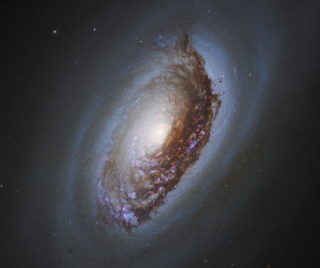
The Black Eye Galaxy is a relatively isolated spiral galaxy 17 million light-years away in the mildly northern constellation of Coma Berenices. It was discovered by Edward Pigott in March 1779, and independently by Johann Elert Bode in April of the same year, as well as by Charles Messier the next year. A dark band of absorbing dust partially in front of its bright nucleus gave rise to its nicknames of the "Black Eye", "Evil Eye", or "Sleeping Beauty" galaxy. M64 is well known among amateur astronomers due to its form in small telescopes and visibility across inhabited latitudes.
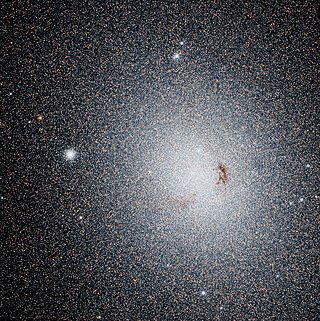
NGC 185 is a dwarf spheroidal galaxy located 2.08 million light-years from Earth, appearing in the constellation Cassiopeia. It is a member of the Local Group, and is a satellite of the Andromeda Galaxy (M31). NGC 185 was discovered by William Herschel on November 30, 1787, and he cataloged it "H II.707". John Herschel observed the object again in 1833 when he cataloged it as "h 35", and then in 1864 when he cataloged it as "GC 90" within his General Catalogue of Nebulae and Clusters. NGC 185 was first photographed between 1898 and 1900 by James Edward Keeler with the Crossley Reflector of Lick Observatory. Unlike most dwarf elliptical galaxies, NGC 185 contains young stellar clusters, and star formation proceeded at a low rate until the recent past. NGC 185 has an active galactic nucleus (AGN) and is usually classified as a type 2 Seyfert galaxy, though its status as a Seyfert is questioned. It is possibly the closest Seyfert galaxy to Earth, and is the only known Seyfert in the Local Group.
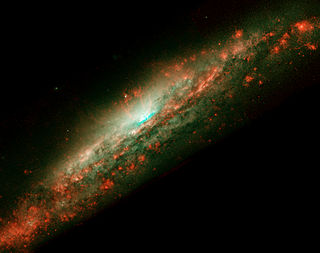
NGC 3079 is a barred spiral galaxy about 50 million light-years away, and located in the constellation Ursa Major. The galaxy was discovered by German-British astronomer William Herschel on 1 April 1790.

NGC 514 is a low-luminosity, intermediate spiral galaxy in the equatorial constellation of Pisces, located at a distance of approximately 83 million light-years from the Milky Way. It was discovered on 16 October 1784 by astronomer William Herschel. The general form of the galaxy is specified by its morphological classification of SAB(rs)c, which indicates it has a weak bar system at the core (SAB), an incomplete ring formation around the bar (rs), and somewhat loosely-wound spiral arms (c). This galaxy has an H II nucleus with an extended region that displays weak emission lines in the optical range, but not in the near infrared. The suspected supermassive black hole at the core has an estimated mass of 3.2×106 M☉.

NGC 4605 is a dwarf barred spiral galaxy in the constellation Ursa Major, located at a distance of 18.1 ± 0.3 megalight-years from the Milky Way. Physically it is similar in size and in B-band absolute magnitude to the Large Magellanic Cloud. It is a member of the M81 Galaxy Group, along with Messier 81 and Messier 101.

Holmberg IX is a dwarf irregular galaxy and a satellite galaxy of M81, located in the constellation of Ursa Major. It is of the Magellanic type of Galaxy as it is similar to the Small Magellanic Cloud, neighbour galaxy to Milky Way Galaxy. The galaxy is named after Erik Holmberg who first described it though it was first found by Sidney van den Bergh. Based on the observed age distribution of stars it contains, a whole 20% of its stellar mass formed within the last 200 Myr, making it the youngest nearby galaxy. It is also home to one of two yellow supergiant eclipsing binary systems.

NGC 5753 is a spiral galaxy in the constellation Boötes. This is a member of the Arp 297 interacting galaxies group of four: NGC 5752, NGC 5753, NGC 5754, NGC 5755.

NGC 5754 is a barred spiral galaxy located 218 million light years away in the constellation Boötes. It was discovered by German-British astronomer William Herschel on 16 May 1787.
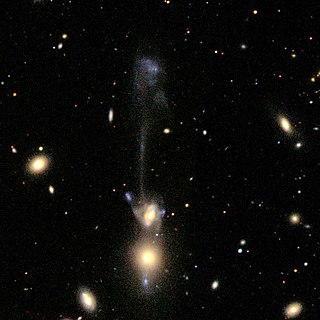
NGC 3561, also known as Arp 105, is a pair of interacting galaxies NGC 3561A and NGC 3561B within the galaxy cluster Abell 1185 in Ursa Major. Its common name is "the Guitar" and contains a small tidal dwarf galaxy known as Ambartsumian's Knot that is believed to be the remnant of the extensive tidal tail pulled out of one of the galaxies.

NGC 4780 is an intermediate spiral galaxy within the constellation Virgo. It is located about 166 million light-years away from the Sun. It was discovered in 1880 by the astronomer Wilhelm Tempel.
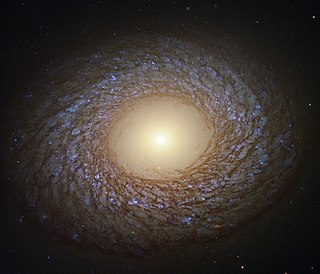
NGC 2775, also known as Caldwell 48, is a spiral galaxy in the constellation Cancer. It is 67 million light-years away from the Milky Way. It was discovered by William Herschel in 1783. NGC 2775 belongs to the Antlia-Hydra Cluster of galaxies and is the most prominent member of the NGC 2775 Group, a small galaxy group in the Virgo Super-cluster, along with the Local Group. Other members of the NGC 2775 Group include NGC 2777 and UGC 4781.

NGC 178 is a Magellanic spiral galaxy in the constellation of Cetus. The compiler of the New General Catalogue, John Louis Emil Dreyer noted that NGC 178 was "faint, small, much extended 0°, brighter middle". It was discovered on November 3, 1885, by Ormond Stone.

NGC 479 is a spiral galaxy in the constellation Pisces. It was discovered by German astronomer Albert Marth on October 27, 1864. It is about 240 million light-years away from Earth.
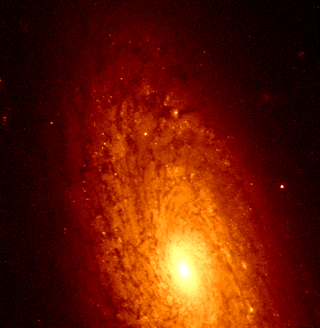
NGC 2090 is a spiral galaxy located approximately 40 million light-years from the Solar System in the Columba constellation. It was discovered on 29 October 1826 by Scottish astronomer James Dunlop. NGC 2090 was studied to refine the Hubble constant to an accuracy within ±10%.

NGC 4242 is a spiral galaxy in the northern constellation of Canes Venatici. The galaxy is about 18 million light years away. It was discovered on 10 April 1788 by William Herschel, and it was described as "very faint, considerably large, irregular, round, very gradually brighter in the middle, resolvable" by John Louis Emil Dreyer, the compiler of the New General Catalogue.

NGC 2998 is a barred spiral galaxy located in the constellation Ursa Major. It is 195 million light-years away from the Earth. It is an intermediate spiral galaxy. Its stellar mass is about that of the Milky Way.

NGC 1487 is an irregular galaxy in the constellation Eridanus. It was discovered by James Dunlop on Oct 29, 1826.

NGC 3898 is a spiral galaxy in the constellation Ursa Major that was discovered by William Herschel on April 14, 1789. It is positioned 1.5° northwest of NGC 3998 and is barely visible in a small telescope. The galaxy has an apparent visual magnitude of 10.7 and an angular size of 3.3′ × 1.5′. It is located at a distance of 72 ± 6 million light-years (22.08 ± 1.79 Mpc) from the Milky Way, and is receding with a heliocentric radial velocity of 1,142.7±13.9 km/s.

NGC 5619 is an intermediate spiral galaxy in the constellation Virgo. The galaxy was found on April 10, 1828, by the British astronomer John Herschel. It is located about 390 million light-years away from the Sun.




















